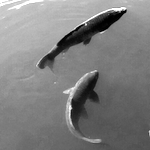Most undulatory natural swimmers exhibit head-first locomotion, where the anterior end of the body leads the posterior end. A notable deviation from this trend is tail-first locomotion observed in mosquito larvae involving a unique large amplitude side-to-side flexural motion of their bodies. Compared to head-first locomotion, our understanding of the parameter space governing this particular type of motion and its energetics remains limited. This study explores the parametric space that supports this type of locomotion and extends this to achieve other gaits. Swimming bouts of Mosquito larvae (Aedes aegypti) were filmed, and their kinematics was digitized using a markerless deep convolutional neural network based tracker. The flowfield was quantified through Particle Image Velocimetry (PIV) analysis. The phase-averaged tail-first gait was then parameterized using simple sinusoids, and a numerical self-propelled model was built with the fluid-structure interactions achieved through Immersed-Boundary Lattice Boltzmann Method (IB-LBM). Self-propelled parameterized gait resulted in tail-first locomotion with flow fields nominally similar to the live experiments. Alterations to the amplitudes and phase differences of the parameterization facilitated the transition from tail-first to head-first swimming which resembled carangiform and anguilliform gaits. Comparisons with head-first gaits reveal that higher speeds were achieved through tail-first gaits, albeit at higher transport costs.

 PDF version
PDF version
